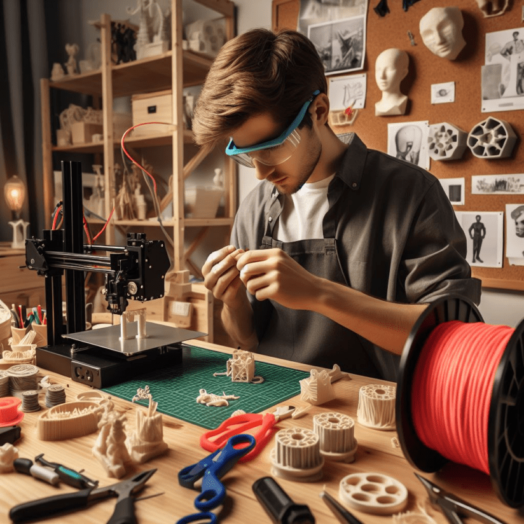“3D printing has been an innovative technology for many years, but it’s only now capturing the spotlight. Originally costly and time-consuming, it was mainly used for creating prototypes. However, with recent advancements in both software and hardware, 3D printing has become more accessible to a wider audience.”

The Evolution and Current State of 3D Printing
A Brief History
The technology of 3D printing, also known as additive manufacturing, has its roots in the 1980s. During its early stages, its use was primarily confined to prototyping due to high costs and a need for more material options. Nevertheless, continuous advancements and innovations have turned 3D printing into a practical and effective manufacturing method with broader applications.
Technological Advancements
Explore the newest breakthroughs in 3D printing! Thanks to recent innovations, 3D printing has become more affordable and capable. Improved software enables complex and precise designs, and faster, more reliable printers make the possibilities endless. Plus, the range of materials that can be used has expanded to include metals, plastics, and even biological materials. It’s an incredibly exciting time for 3D printing!
3D Printing: A Growing Yet Niche Market
Current Adoption and Market Growth
“Get ready to witness the incredible rise of 3D printing! Although not widely used in households yet, the adoption of this groundbreaking technology is skyrocketing. In 2020, the global 3D printing market was valued at $2.5 billion, and brace yourself, because it’s projected to soar to a colossal $12.8 billion by 2025! This phenomenal growth is fueled by the demand for lightning-fast prototyping, production of spare parts, and the integration of 3D printing in diverse industries for real-world applications. The future is here, and it’s nothing short of exhilarating!”
Small Businesses and Entrepreneurship
The emergence of 3D printing technology has revolutionized the way small businesses and entrepreneurs operate. This innovative technology enables the creation of unique, custom products without requiring substantial initial investment. However, it does necessitate proficiency in digital design skills. Once these skills are acquired, they pave the way for countless opportunities for innovation and the expansion of business prospects.
Industry Applications and Innovations
Aerospace and Defense
The revolutionary technology of 3D printing has significantly impacted the aerospace and defense industries. The United States government has adopted additive manufacturing to produce intricate parts needed for the Space Launch System (SLS) rocket. This adoption showcases the technology’s capability to efficiently manufacture intricate high-performance components with reduced production time and cost, ultimately benefiting the aerospace and defense sectors.
Medical and Dental
In medicine, 3D printing technology is widely used to fabricate personalized implants, prosthetics, and biofabricated tissues. Notably, the UK government has shown a keen interest in funding research aimed at leveraging 3D printing for the production of food and pharmaceuticals. This significant investment signifies the potential for further advancements and expansion in this innovative domain.
Consumer Products
The use of 3D printing in the consumer market is rapidly growing. This technology is now applied to various products, including custom eyewear and personalized footwear. As a result, more and more people can access tailored products. Leading companies such as 3D Systems are capitalizing on this trend by expanding their product offerings to meet the increasing demand. They now provide top-of-the-line printers capable of handling a variety of high-quality materials.
Pioneering Companies and Technologies
Upson-DeLee Technology is an innovative additive manufacturing process that has revolutionized the capabilities of 3D printing with polymers. This groundbreaking technology significantly improves the properties of various polymers, allowing them to be effectively utilized in 3D printing applications. By leveraging Upson-DeLee, materials such as polystyrene, polycarbonate, and polyethylene, renowned for their toughness and impact resistance, can be seamlessly incorporated into additive manufacturing processes. This expansion in material options has opened up new possibilities for various applications, offering enhanced performance and durability in 3D-printed products.
Collaborative Efforts
Collaborations between companies and research institutions are crucial in pushing the boundaries of 3D printing technology. One notable example is the partnership between UPS and Pregis, which has created innovative polymer materials such as Tritan™. These new materials have been specifically designed to improve the strength and longevity of 3D-printed components, opening up new possibilities for the technology.
Future Outlook and Potential
Market Expansion
The 3D printing market is poised for significant growth as technological advancements drive accessibility and affordability. The emergence of desktop systems and high-speed printing technologies is streamlining the adoption of 3D printing within the commercial and consumer sectors. These developments pave the way for a broader integration of 3D printing across various industries and applications.
Digital Manufacturing
Integrating digital manufacturing processes with cloud computing revolutionizes how products are designed and produced. By leveraging cloud computing, designers, engineers, and manufacturers can collaborate more closely, resulting in accelerated and highly efficient production cycles. This approach could streamline the entire manufacturing ecosystem by enabling real-time data sharing, improved design iteration, and seamless production coordination.
Sustainability and Innovation
3D printing provides sustainability benefits by minimizing waste through the efficient use of materials and enabling on-demand production, which helps reduce excess inventory and transportation emissions. By disrupting traditional manufacturing methods, 3D printing fosters more innovative and environmentally friendly production practices, leading to a more sustainable and resource-efficient manufacturing industry.
Conclusion,
3D printing has evolved from a niche technology for prototyping to a transformative tool with broad applications across various industries. As technology advances, new opportunities will arise for businesses and entrepreneurs, leading to innovation and economic growth. Embracing 3D printing early will position individuals and organizations to reap its benefits in the future.
—
Thank you for reading! If you have any questions or comments, please leave them below.
Start your 3D printing journey [HERE]!
Bullwinkle


